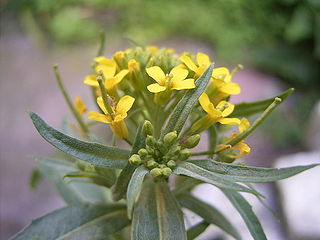Denitrobacterium is a genus of Actinomycetota with a single species, in the family Coriobacteriaceae. Originally isolated from the bovine rumen, Denitrobacterium are non-motile and non-spore forming. The only described species in this genus is Denitrobacterium detoxificans. The specific niche of this bacterium in the bovine rumen is theorized to be the detoxification/metabolism of nitrotoxins and miserotoxin.

Lamium album, commonly called white nettle or white dead-nettle, is a flowering plant in the family Lamiaceae. It is native throughout Europe and Asia, growing in a variety of habitats from open grassland to woodland, generally on moist, fertile soils.

Ipomopsis aggregata is a species of biennial flowering plant in the phlox family (Polemoniaceae), commonly known as scarlet trumpet, scarlet gilia, or skyrocket because of its scarlet red flowers with lobes curving back as if blown back by rocketing through the air.

Phenanthrenoids are chemical compounds formed with a phenanthrene backbone. These compounds occur naturally in plants, although they can also be synthesized.

Erysimum cheiranthoides, the treacle-mustard,wormseed wallflower, or wormseed mustard is a species of Erysimum native to most of central and northern Europe and northern and central Asia. Like other Erysimum species, E. cheiranthoides accumulates two major classes of defensive chemicals, glucosinolates and cardiac glycosides.

Catalpol is an iridoid glucoside. This natural product falls in the class of iridoid glycosides, which are simply monoterpenes with a glucose molecule attached.

Ononin is an isoflavone glycoside, the 7-O-β-D-glucopyranoside of formononetin, which in turn is the 4'-O-methoxy derivative of the parent isoflavone daidzein.

Eupatolin is a chemical compound. It is a flavonol rhamnoside attached at the 3 position to an eupatolitin molecule. It can be found in Eupatorium ligustrinum.
Flavonolignans are natural phenols composed of a part flavonoid and a part phenylpropane.

Ombuin is an O-methylated flavonol, a type of flavonoid. It is the 4',7-O-methyl derivative of quercetin.

Syringetin is an O-methylated flavonol, a type of flavonoid. It is found in red grape, in Lysimachia congestiflora and in Vaccinium uliginosum. It is one of the phenolic compounds present in wine.

Brickellin is an O-methylated flavonol. It can be found in Brickellia veronicifolia.

Quercetagetin is a flavonol, a type of flavonoid. It can be found in the genus Eriocaulon.

Eupalitin is an O-methylated flavonol. It can be found in Ipomopsis aggregata.

Patuletin is an O-methylated flavonol. It can be found in the genus Eriocaulon.

Axillarin is an O-methylated flavonol. It can be found in Pulicaria crispa, Filifolium sibiricum, Inula britannica, Wyethia bolanderi in Balsamorhiza macrophylla and in Tanacetum vulgare. It can also be synthesized.

Mearnsetin is an O-methylated flavonol. It can be found in Eucalyptus globulus and in Elaeocarpus lanceofolius. The compound has antioxidative properties.

Rotenoids are naturally occurring substances containing a cis-fused tetrahydrochromeno[3,4-b]chromene nucleus. Many have insecticidal activity, such as the prototypical member of the family, rotenone. Rotenoids are related to the isoflavones.

Kaempferol-3-O-rutinoside is a bitter-tasting flavonol glycoside. It can be isolated from the rhizomes of the fern Selliguea feei.
Tephrosia spinosa is a flowering plant species in the genus Tephrosia native from India, Sri Lanka, Malaysia and Indonesia.

















